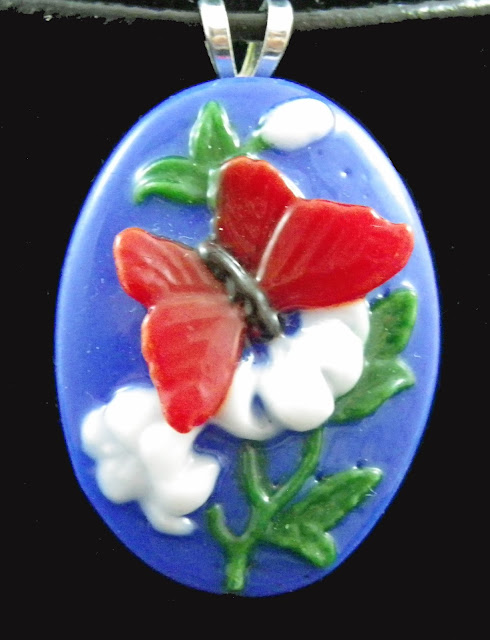Bubbles are great if you are using bubble paint like UGC's artisan line and not so great when the pop up in the middle of a beautiful piece you worked hard on. Here is a quick tutorial on what I do to eliminate almost all of them.
First a note on my kiln and firing schedules. I bought a JenKen Bonnie Glo fiber kiln a little over 2 years ago. I highly recommend this kiln for a starting kiln. Inside dimensions are 15 inches diameter by 6 inches high and you can use almost all of that room, You can fire stuff on the bottom of the kiln with either kiln wash or fiber paper. I didn't own a shelf until recently. You can also fire many things made with 1 or more layers (3mm) of glass very quickly. The company has a picture of a bowl with all of their kiln advertisements that was fired in 1 1/2 hours. You can totally do that, but in my experience you will get.... can you guess... BUBBLES! I frequently fire 2 layers of glass like used in this tutorial as fast as possible up to 1125 degrees in this kiln. All of that being said with glass slower is usually better. If you do not have a fiber kiln I recommend using your own schedules and not mine. The best thing you can do is know your own kiln.
Bubbles were one of my first frustrations with fused glass work. I made a little piano plate for a friend and it was all bumpy and lumpy from bubbles. Being a piano teacher she loved it anyway. My next piece was a pretty pink bowl that was full of bubbles.
I did a little research and found 2 things out.
1. Slow things down!
2. Use a thin amount of clear powder between layers.
So here is a basic full fuse firing schedule with a bubble squeeze added.
300/hour to 1125
50/hour to 1225
hold for 30 minutes
250/ hour to 1475
hold for 10 minutes
Full to 960
Hold for 60 minutes
Full to 100
Now I get a lot of questions about adding the powder layer. Number one question is "won't that make the piece foggy or hazy? I have never had a problem with that but it will if you use too much powder. Here is how I do things.
9" x 9" Blackberries and Cream S96 Opal Art Glass. This is one of my all time favorite pieces.
I use clear powder frit.
Use a spoon to put the clear powder into a sifter
(please wear a mask when using glass powders)
Tap the sifter to spread powder all of the glass in a thin layer. Use a piece of paper under the glass to catch excess powder. This makes it easy to put back in the jar.
What it looks like when I am done
Cap it with the same sized clear glass and place it in the kiln. Use a kiln shelf if you have a brick kiln. Fire using a schedule with a bubble squeeze like the one above
This is the same sheet of glass after a full fuse. Over all there is no large bubbles.
There are still a few small champagne bubbles but these are normal in fused glass work.
I use this same basic technique for most of the pieces I full fuse. It works on sheet glass, dichroic, iridescent etc. You may get some small bubbles, but most large ones that interfere with the look of a piece will be eliminated.





















